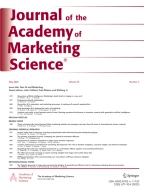Abstract
Four studies were conducted to test the hypothesis that (1) consumer behavior is more strongly predicted by functional congruity than by self-congruity, and (2) functional congruity is influenced by self-congruity. The pattern of the results provides support for hypotheses.
Similar content being viewed by others
References
Abelson, R. P. 1976. “A Script Theory of Understanding, Attitude, and Behavior”. InCognition and Social Behavior. Eds. J. Carroll and T. Payne, Hillsdale, NJ: Erlbaum.
Anderson, John R. 1980.Cognitive Psychology and Its Implications. San Francisco, CA: Freeman.
Ajzen, Icek and Martin Fishbein 1980.Understanding Attitudes and Predicting Social Behavior. Englewood Cliffs, NJ: Prentice-Hall.
Bass, Frank M. and W. Wayne Talarzyk 1972. “An Attitude Model for the Study of Brand Preferences.”Journal of Marketing Research 9 (February): 93–96.
Birdwell, A. E. 1968. “A Study of Influence of Image Congruence on Consumer Choice”.Journal of Business 41: 76–88.
Claiborne, C. B. and M. Joseph Sirgy 1990. “Self-Image Congruence as a Model of Consumer Attitude Formation and Behavior: A Conceptual Review and Guide for Future Research”. InDevelopments in Marketing Science, Vol. 13, pp. 1–7. Ed. B.J. Dunlap. Cullowhee, NC: Academy of Marketing of Marketing Science.
Dilehay, R., C. Insko, and M. Smith 1966. “Logical Consistency and Attitude Change”.Journal of Personality and Social Psychology 3: 646–654.
Dolich, Ira J. 1969. “Congruence Relationship between Self-Images and Product Brands”Journal of Marketing Research 6 (February): 80–84.
Eriksen, Mary Kay and M. Joseph Sirgy 1989. “Achievement Motivation and Clothing Behavior of Working Women”.Journal of Social Behavior and Personality 4 (4): 307–326.
Fishbein, Martin and Icek Ajzek 1975.Belief, Attitude, Intention, and Behavior: An Introduction to Theory and Research. Reading, MA: Addison-Wesley.
Grubb, E. L. and B. L. Stern 1971. “Self-Concept and Significant Others”.Journal of Marketing Research 8: 382–385.
Lincoln, Douglas J. 1978. “The Effects of Comparative-Advertising on the Department Store Image: An Experimental Analysis”. Dissertation Virginia Polytechnic Institute and State University at Blacksburg.
Lutz, Richard J. and James R. Bettman 1977. “Multiattribute Models in Marketing: A Bicentennial Review. InConsumer and Industrial Buying Behavior, pp. 137–150. Eds. A. G. Woodside, J. N. Sheth, and P. D. Bennet. New York, NY: Elsevier-North Holland Publishing.
Maheshwari, A. K. 1974.Self-Product Image Congruence: A Macro-Level Analysis. Ann Arbor, MI: University Microfilms International.
Malhotra, Naresh. 1981. “A Scale to Measure Self-Concepts, Person Concepts, and Product Concepts”,Journal of Marketing Research 18: 456–464.
Malhotra, Naresh. 1988. “Self-Concept and Product Choice: An Integrated Perspective”.Journal of Economic Psychology 9.
Markus, Hazel. 1980. “The Self in Thought and Memory”. InThe Self in Social Psychology, Eds. Daniel M. Wegner and Robin R. Vallacher. New York, NY: Oxford University Press.
Mason, J. Barry and M. L. Mayer. 1970. “The Problem of the Self-Concept in Store Studies”.Journal of Marketing 34 (April): 67–69.
Mason, J. Barry and M. L. Mayer 1973. “Insight into the Image Determinants of Fashion Specialty Outlets”Journal of Business Research 1 (Summer): 73–80.
McGuire, W.J. 1960. “A Syllogistic Analysis of Cognitive Relationships”. InAttitude Organization and Change Ed. M. J. Rosenberg, C. I. Hovland, W. J. McGuire, R. P. Ableson, and J. W. Brehm. New Haven, CT: Yale University Press.
Meyer, R. J. 1981. “A Model of Multiattribute Judgments under Attribute Uncertainty and Informational Constraint”.Journal of Marketing Research, 18 (November): 428–444.
Neisser, Urlic 1976.Cognition and Reality: Principles and Implications of Cognitive Psychology. San Francisco, CA: Freeman.
Nisbett, Richard and Lee Ross. 1980.Human Inference: Strategies and Shortcomings of Social Judgement. Englewood Cliffs, NJ: Prentice-Hall.
Rosenberg, Milton, J. 1956. “Cognitive Structure and Attitudinal Affect”.Journal of Abnormal and Social Psychology 53 (November): 367–372.
Ross, Ivan 1974. “Self-Concept and Brand Preference”Journal of the University of Chicago 44: 38–50.
Samli, A. C. 1976. “Segmentation Index and Store Image in Retail and Service Establisments: A New Direction in Marketing Research for Retailers.” InResearch that Works for Today’s Marketing Problems. Proceedings of ESOMAR Conference, pp. 143–155. Venice, Italy.
Samli, A. C. and M. Joseph Sirgy 1981. “A Multidimensional Approach to Analyzing Store Loyalty: A Predictive Model”. InThe Changing Marketing Environment: New Theories and Applications, pp. 113–116. Eds. Ken Bernhardt and Bill Kehoe. Chicago, IL: American Marketing Association.
Sheth, Jagdish. 1973. “Brand Profiles from Beliefs and Importance”,Journal of Advertising Research 13 (February): 37–42.
Sheth, Jagdish and W. Wayne Talarzyk 1972. “Perceived Instrumentality and Value Importance as Determinants of Attitudes”.Journal of Marketing Research 9 (February): 6–9.
Sirgy, M. Joseph. 1982. “Self-Concept in Consumer Behavior: A Critical Review”.Journal of Consumer Research 9 (December): 287–300.
—. 1985a. “Self-Image/Product-Image Congruity and Consumer Decision-Making”International Journal of Management 2 (December): 49–63.
— 1985b. “Using Self-Congruity and Ideal Congruity to Predict Purchase Motivation”.Journal of Business Research 13 (June): 195–206.
— 1986.Self-Congruity: Toward a Theory of Personality and Cybernetics. New York, NY: Praeger Publishers.
— 1990. “Self-Cybernetics: Toward an Intergrated Model of Self-Concept Processes”.Systems Research 7 (1): 19–32.
Sirgy, M. Joseph and Jeffrey Danes. 1982. “Self-Image/Product-Image Congruence Models: Testing Selected Models” InAdvances in Consumer Research, Vol. 9, pp. 556–561. Ed. Andrew Mitchell. Ann Arbor, MI: Association for Consumer Research
Sirgy, M. Joseph and A. C. Samli 1985. “A Path Analytic Model of Store Loyalty Involving Self-Concept, Store Image, Socioeconomic Status, and Geographic Loyalty”.Journal of the Academy of Marketing Science 13 (Summer): 265–291.
Snyder, Mark L. 1979. “Self-Monitoring Processes” InAdvances in Experimental Social Psychology, Vol. 12, 86–128. Ed. Leon Berkowitz New York, NY: Academic Press.
Wildt, A. R., A. V. Bruno, and J. L. Ginter 1981. “Attitude Models”Journal of Advertising Research 21 (August): 61–70.
Wilkie, William and Edgar A. Pessemier 1973. “Issues in Marketing’s Use of Multiattribute Attitude Models”.Journal of Marketing Research 10 (November): 428–441.
Wyer, Robert S., Jr. and Donald E. Carlston. 1979.Social Cognition, Inference, and Attribution. Hillsdale, NJ: Erlbaum.
Author information
Authors and Affiliations
Rights and permissions
About this article
Cite this article
Sirgy, M.J., Johar, J.S., Samli, A.C. et al. Self-congruity versus functional congruity: Predictors of consumer behavior. JAMS 19, 363–375 (1991). https://doi.org/10.1007/BF02726512
Issue Date:
DOI: https://doi.org/10.1007/BF02726512
